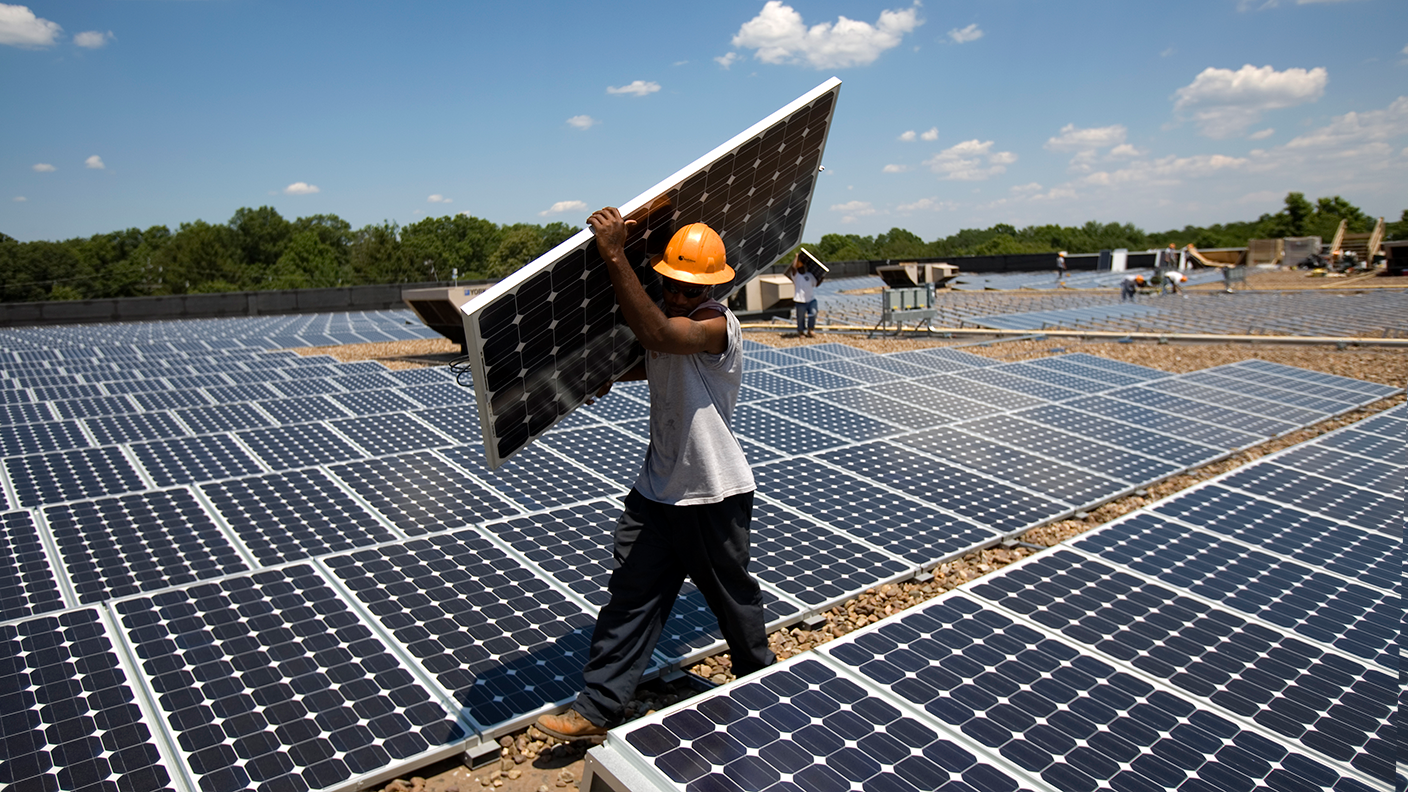How green bonds will fund the coming energy transition
The need to cut carbon emissions will see a huge amount of investment in new infrastructure and clean energy projects, funded by the most simple of financial instruments – a bond. David Stevenson looks at the huge potential to investors of “green bonds”.

Policy makers around the world now pretty much agree that we somehow need to cut growth in global carbon emissions. The aim is to prevent the planet from warming by more than 1.5 degrees Celsius over the next few decades (and hopefully less).
As an investor, your view of this particular goal – whether you think it’s overdone, or not nearly aggressive enough – is irrelevant. Instead, investors should recognise the political reality, and consider what it means for the investment backdrop.
And the most obvious point on that front is that it’s going to involve investing and spending a great deal of money.
MoneyWeek
Subscribe to MoneyWeek today and get your first six magazine issues absolutely FREE

Sign up to Money Morning
Don't miss the latest investment and personal finances news, market analysis, plus money-saving tips with our free twice-daily newsletter
Don't miss the latest investment and personal finances news, market analysis, plus money-saving tips with our free twice-daily newsletter
How to pay for cutting carbon emissions
Cutting carbon emissions globally is going to require a huge amount of investment – not only in developing new technologies, but in building new infrastructure to withstand rising sea levels and increased weather variability.
A report last year from asset manager Amundi and the World Bank’s IFC gives an idea of the costs and opportunities for the developing world alone. Untapped investment opportunities in emerging market cities are reckoned to be worth $29trn across six key sectors – waste, renewable energy, public transport, water, electric vehicles, and green buildings – up to 2030 alone.
In any other sphere of economic activity, that sort of blizzard of new investment would probably involve some form of debt funding, usually with the issuance of bonds to raise fresh capital. And this is no exception.
However, within the world of ESG investing – strategies which focus on environmental, social and governance concerns – the burden will probably fall on a relatively new form of bond, called a green bond.
To understand how these innovative new structures work, its best perhaps to consider a recent example from Europe. In spring this year, the Dutch government issued one of the largest green bonds to date: a €5.98bn green bond. The bond will be used to finance, among other things, natural infrastructure solutions in the Netherlands, which are crucial for protecting one of the world's lowest-lying countries from floods and sea-level rise.
The Dutch government can repay investors with money raised through a variety of tax and revenue sources. This highly-rated bond (its credit rating is the top grade, AAA) proved hugely popular with large financial institutions – within 90 minutes of the bond's issuance, the Dutch government had received €21.2bn-worth of orders for just €5.98bn of certificates, meaning the bond was “over-subscribed” by three and a half times.
Like all green bonds, funds raised by this issuance have to pass certain ESG standards. These include reporting on the impact of the projects that they are financing; screening for a positive outcome (the Dutch bond was certified by something called the “Climate Bonds Initiative”); and a guarantee that the funds won’t be used for “negative” activities, such as, for example, funding oil exploration.
So far, going green doesn’t mean sacrificing returns
This mammoth Dutch issue is just the latest in a series of green bond issues. In the not-too-distant past, China, France, Nigeria, Indonesia, Fiji and dozens of other nations have also issued green bonds. And in September, the German government raised €6.5bn from its own ten-year green bond. This also proved hugely popular – demand for the climate-focused bond amounted to more than €33bn.
One widely-watched green bond index (the ICE BofAML Green Bond Index) has shown that the amount invested in bonds with an environmental impact has grown from $55bn in 2015 to $345bn as of 31 October last year.
According to another measure, the period between 2012 and 2018 saw cumulative issuance of green bonds totalling $140bn, across 28 markets. According to the IFC, that could increase to between $210bn and $250bn by 2021.
As green bond issuance has increased, we’ve also seen an explosion in the number of funds which invest in these bonds. According to a report earlier this year by research group Scope Analysis GmbH (looking at data from 2019), assets under management by green bond funds more than doubled in one year.
In Europe, there are now 29 of these funds, with assets under management amounting to €5.8bn. All of these bond funds have enjoyed positive returns so far – according to Scope, all 29 of the funds achieved positive returns of between 0.8% and 9.7% by the end of October 2019.
Much as these numbers sound impressive, it‘s also important to keep some perspective. A report from Deutsche Bank earlier this year reminded us that green bonds are still a very small segment of the global bond market. And since the Covid pandemic, the rate of growth has slowed down – Deutsche Bank analysts reckon that in 2020 so far, green bond issuance is running at a third of last year’s level.
That said, the report also observed that green bonds have been performing in line with most other classes of bonds – Deutsche’s index of green bonds “has broadly tracked the performance of regular investment grade bonds in both the US and Europe”.
This is critical – if green bonds don’t involve much negative drag on performance but also produce a positive outcome in environmental terms, then there doesn’t seem to be much downside for ethical investors.
Looking to the future, many institutional investors reckon that the greatest growth potential for green bonds is probably not in the countries such as The Netherlands and Germany, but in the developing world, and especially Asia.
More than 80% of recent issuance by developing countries has been by China, with the East Asia and the Pacific region responsible for 81% of the market. Green bonds issued have raised anything from $1.5m to $4.4bn, with an average issue size of $385m. About half of the bonds boast a formal credit rating, and nearly always investment grade – ie, lowest risk.
As with so many things in the world of investment, the future may now be taking shape in Asia, with our mammoth transition to clean energy being funded by the most simple of financial instruments – a bond.
Get the latest financial news, insights and expert analysis from our award-winning MoneyWeek team, to help you understand what really matters when it comes to your finances.

David Stevenson has been writing the Financial Times Adventurous Investor column for nearly 15 years and is also a regular columnist for Citywire.
He writes his own widely read Adventurous Investor SubStack newsletter at davidstevenson.substack.com
David has also had a successful career as a media entrepreneur setting up the big European fintech news and event outfit www.altfi.com as well as www.etfstream.com in the asset management space.
Before that, he was a founding partner in the Rocket Science Group, a successful corporate comms business.
David has also written a number of books on investing, funds, ETFs, and stock picking and is currently a non-executive director on a number of stockmarket-listed funds including Gresham House Energy Storage and the Aurora Investment Trust.
In what remains of his spare time he is a presiding justice on the Southampton magistrates bench.
-
 Taxpayers urged to fight automated HMRC penalties as 20,000 win on appeal
Taxpayers urged to fight automated HMRC penalties as 20,000 win on appealHMRC loses more than 60% of cases when taxpayers appeal an automated penalty it has imposed, new figures show.
-
 More than five million taxpayers overpay with wrong tax codes – how to check yours is right
More than five million taxpayers overpay with wrong tax codes – how to check yours is rightHMRC overcharged taxpayers £3.5 billion in income tax the latest data shows, with tax coding errors largely to blame. Accountants say it is “essential” people check their tax codes to avoid being hit with higher bills.
-
 Halifax: House price slump continues as prices slide for the sixth consecutive month
Halifax: House price slump continues as prices slide for the sixth consecutive monthUK house prices fell again in September as buyers returned, but the slowdown was not as fast as anticipated, latest Halifax data shows. Where are house prices falling the most?
-
 Rents hit a record high - but is the opportunity for buy-to-let investors still strong?
Rents hit a record high - but is the opportunity for buy-to-let investors still strong?UK rent prices have hit a record high with the average hitting over £1,200 a month says Rightmove. Are there still opportunities in buy-to-let?
-
 Pension savers turn to gold investments
Pension savers turn to gold investmentsInvestors are racing to buy gold to protect their pensions from a stock market correction and high inflation, experts say
-
 Where to find the best returns from student accommodation
Where to find the best returns from student accommodationStudent accommodation can be a lucrative investment if you know where to look.
-
 The world’s best bargain stocks
The world’s best bargain stocksSearching for bargain stocks with Alec Cutler of the Orbis Global Balanced Fund, who tells Andrew Van Sickle which sectors are being overlooked.
-
 Revealed: the cheapest cities to own a home in Britain
Revealed: the cheapest cities to own a home in BritainNew research reveals the cheapest cities to own a home, taking account of mortgage payments, utility bills and council tax
-
 UK recession: How to protect your portfolio
UK recession: How to protect your portfolioAs the UK recession is confirmed, we look at ways to protect your wealth.
-
 Buy-to-let returns fall 59% amid higher mortgage rates
Buy-to-let returns fall 59% amid higher mortgage ratesBuy-to-let returns are slumping as the cost of borrowing spirals.
